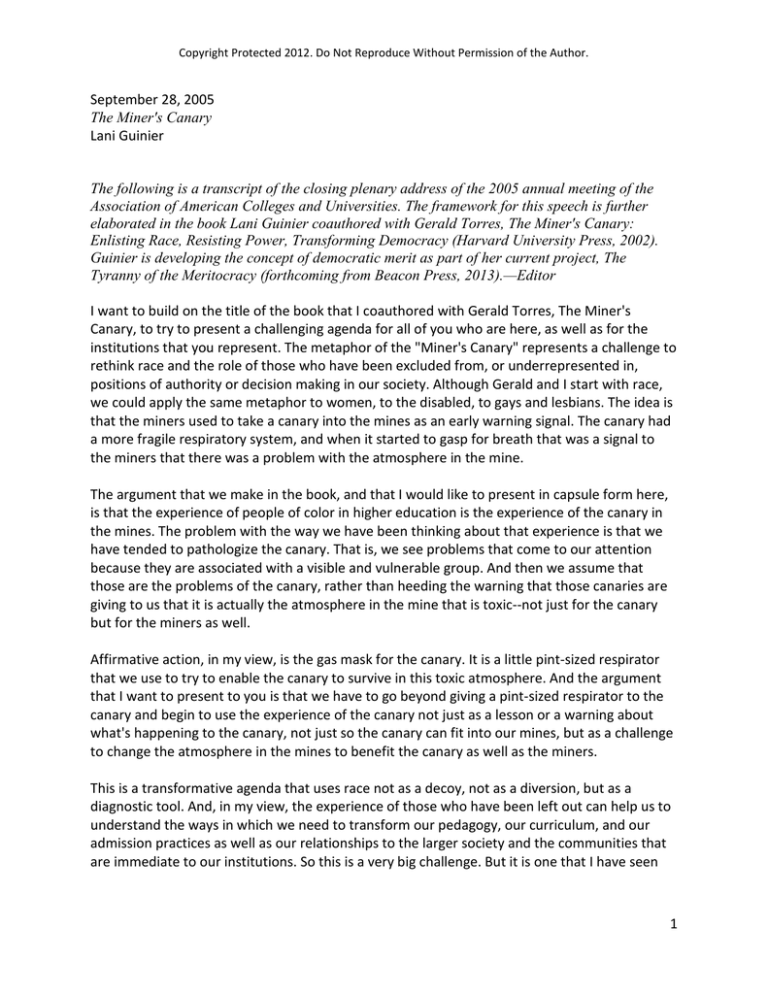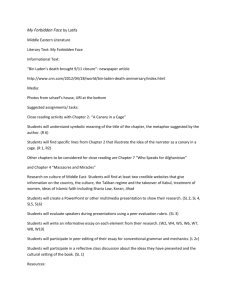September 28, 2005 Lani Guinier The Miner's Canary
advertisement

Copyright Protected 2012. Do Not Reproduce Without Permission of the Author. September 28, 2005 The Miner's Canary Lani Guinier The following is a transcript of the closing plenary address of the 2005 annual meeting of the Association of American Colleges and Universities. The framework for this speech is further elaborated in the book Lani Guinier coauthored with Gerald Torres, The Miner's Canary: Enlisting Race, Resisting Power, Transforming Democracy (Harvard University Press, 2002). Guinier is developing the concept of democratic merit as part of her current project, The Tyranny of the Meritocracy (forthcoming from Beacon Press, 2013).—Editor I want to build on the title of the book that I coauthored with Gerald Torres, The Miner's Canary, to try to present a challenging agenda for all of you who are here, as well as for the institutions that you represent. The metaphor of the "Miner's Canary" represents a challenge to rethink race and the role of those who have been excluded from, or underrepresented in, positions of authority or decision making in our society. Although Gerald and I start with race, we could apply the same metaphor to women, to the disabled, to gays and lesbians. The idea is that the miners used to take a canary into the mines as an early warning signal. The canary had a more fragile respiratory system, and when it started to gasp for breath that was a signal to the miners that there was a problem with the atmosphere in the mine. The argument that we make in the book, and that I would like to present in capsule form here, is that the experience of people of color in higher education is the experience of the canary in the mines. The problem with the way we have been thinking about that experience is that we have tended to pathologize the canary. That is, we see problems that come to our attention because they are associated with a visible and vulnerable group. And then we assume that those are the problems of the canary, rather than heeding the warning that those canaries are giving to us that it is actually the atmosphere in the mine that is toxic--not just for the canary but for the miners as well. Affirmative action, in my view, is the gas mask for the canary. It is a little pint-sized respirator that we use to try to enable the canary to survive in this toxic atmosphere. And the argument that I want to present to you is that we have to go beyond giving a pint-sized respirator to the canary and begin to use the experience of the canary not just as a lesson or a warning about what's happening to the canary, not just so the canary can fit into our mines, but as a challenge to change the atmosphere in the mines to benefit the canary as well as the miners. This is a transformative agenda that uses race not as a decoy, not as a diversion, but as a diagnostic tool. And, in my view, the experience of those who have been left out can help us to understand the ways in which we need to transform our pedagogy, our curriculum, and our admission practices as well as our relationships to the larger society and the communities that are immediate to our institutions. So this is a very big challenge. But it is one that I have seen 1 Copyright Protected 2012. Do Not Reproduce Without Permission of the Author. some schools take on, and their successes, although modest, can inspire the rest of us not to fear this risky but potentially very fulfilling agenda. The university and the community I want to start by talking a little bit about Clark University in Worcester, Massachusetts, which essentially looked at the experience of the canaries in Worcester and used that investigation to build a university-community partnership. They realized that Clark University was located amidst a community that was in trouble. The crime rates in the neighborhood were high; the number of young people who were not graduating from high school was high. The infrastructure, in terms of the housing in that community, was crumbling. And the school was beginning to consider relocating its campus because it was afraid it would not be able to attract students or faculty. But instead of running away, the school began to explore ways that it could become more involved with its community--and not just by inviting students to engage in random charitable volunteer service activities, but by inviting members of the community to sit down and begin to imagine a new future in which the university and the community both would benefit. One of the most interesting projects that this institution embarked upon was to begin its own high school. The school started in the seventh grade. It admitted students by lottery. That's a really important point: by lottery. It admitted students by lottery from the surrounding community. And I just want to give you a little bit of a sense of who these students were. In the first group of seventh graders, only 1 percent of the students were reading at grade level. Thirty percent were reading three grades behind. Seventy-five percent of the students qualified for free lunch. About three-fifths of the students were students of color. They were *all* admitted by lottery. By the time this first group that came in the seventh grade was in the tenth grade, they all passed the Massachusetts Comprehensive Assessment System exam. In 2003, when the first class graduated, they sent their graduates to Brown, Georgetown, Tufts, and Holy Cross. And five students were admitted and attended Clark University on full scholarships. When Damian Ramsey, one of these graduates, enrolled as a seventh grader, he was reading at the fourth-grade level. He was unable to multiply. Six years later, he graduated and went to Brown University. He credits much of his success to the sheer belief and determination of his teachers. He said that if someone puts so much work into you, you don't want to let them down. You don't want to show them that their work is in vain. A lot of the students didn't want to disappoint their teachers, but it wasn't just the teachers; it was also the fact that this high school was part of a collaborative arrangement with a university that was putting its resources and its goodwill behind the success of the high school. And indeed, the executive assistant to the president of Clark attributes the success of the high school to the university's commitment to broader transformation in the surrounding community. "What we found," he said, "was having only one piece of the puzzle alone won't work. You can work in education all you want but if the housing is substandard, if the 2 Copyright Protected 2012. Do Not Reproduce Without Permission of the Author. neighborhood is not safe, if people can't find jobs then the whole thing falls apart. Bricks and mortar alone won't revitalize the neighborhood." Clark University's experiment demonstrates the value of looking beyond the SAT scores of current applicants or the citation index to measure productivity of faculty who are already part of its campus. Clark is an institution that is beginning to look to the future-- not only the future of that university, but the future of the community. And that is the move that I think the Miner's Canary presses us to consider and, as a result, it presses us to contemplate a more transformative agenda. Democratic merit Consider the traditional admissions process at selective institutions. There has been too much attention focused on looking for predictors of student success based on past achievement. There has been too little attention devoted to looking for ways that our institutions can invest in students who are committed to serving our democracy and making future contributions to its success. A transformative agenda would move from a reward-based system that rewards individual past achievement to an investment-based system that is investing in the broader democratic potential of our society. I call this investment-based system "democratic merit." It is a system that encourages future action to promote the conditions of a thriving democracy. Democratic merit seeks to broaden our agenda. It challenges us to reconsider, when we hire faculty or when we admit students, whether it is enough to look for individuals who have already succeeded. Instead, democratic merit pushes us to change or shift our gaze and to invest in communities and students whose very success means we can all succeed in the future together. Democratic merit is about moving away, for example, from an individualistic, test-centric view of merit, what I call "testocracy," in which we rank and sort individuals based on so-called objective criteria with the false promise that these criteria are going to predict academic success. The testocracy offers a false promise because even though there is some modest correlation between SAT scores and first-year college grades, it is truly modest. And indeed, the economist Jesse Rothstein, a professor at Princeton, (who is now at UC Berkeley) did a study of 22,000 California students and found that the SAT is actually a good proxy for family background. If all you're interested in doing is predicting first-year success, academic success, then it is not problematic to use an admissions test that benefits upper-middle-class whites. You are essentially giving them the chance to succeed because they are the ones who are most likely to do well during the first year of college. However, those who do well on multiple-choice, timed tests may not be the ones you might admit if you are looking towards the future, if you are trying to invest your resources in those who are going to become leaders in their community, who are going to contribute to the larger society, who are going to give back to the communities that have invested in them. If future contribution to the collective good is one of your institution's values, you may want to 3 Copyright Protected 2012. Do Not Reproduce Without Permission of the Author. reconsider the current emphasis on predictors that attempt to rank and sort based on past performance. Researchers at the University of Michigan Law School, for example, surveyed their graduates over a thirty-year period to determine who best fulfilled the mission of that law school. The mission of that school was to graduate students who did well financially, who enjoyed their careers, and who became leaders in their communities. Those with the highest entry-level credentials, the highest LSAT scores, were no more likely to do well financially than any of their peers. Everyone who went to the University of Michigan Law School basically did well financially. Those with the highest incoming academic credentials were no more likely to enjoy their careers than were their peers. In fact, in one particular age cohort, those with the highest credentials experienced greater career dissatisfaction. One hypothesis was that these high-performing students did really well on timed, objective, multiple-choice tests of quick strategic guessing with less than perfect information. These students came to believe, based on their high test scores--and this is the hypothesis--that they were somehow entitled to what they were getting and that there was a right answer to every problem. The most important finding in my view, however, was about the students who became leaders. Those with the highest entry-level credentials were among those least likely to become leaders in their communities. They were among those least likely to mentor younger attorneys, to serve on community boards, to do public service or take pro bono cases. And who were the students, and then the graduates, who were the most likely to fulfill all three elements of the law school's mission? The black and Latino students who were admitted pursuant to affirmative action. The black and Latino students did well financially, enjoyed their careers, and were among those most likely to become leaders in their communities. Now that's part of what I call "confirmative action," that's part of the idea of the Miner's Canary. We need to study whatever it was that the University of Michigan Law School was doing in admitting those "canaries" and use that insight in deciding how to admit all students, not just the black and Latino students. We should confirm the lessons of affirmative action and apply them more broadly to inform our judgments about all applicants. But the University of Michigan Law School findings also suggest that we may need to rethink what's happening in the classroom. One of the research hypotheses is that the black and Latino students became leaders because they were so alienated from the law school classroom while they were there that they spent their time engaged in extracurricular activities. They learned to function as leaders, and practice makes perfect. My point is that universities are not functioning as learning organizations that train leaders and citizens to thrive in a democracy. And to diagnose this challenge, we need to shift from pathologizing the canaries to learning from the canaries. We need to study the experience of those who have been left out or underrepresented. We need to study the canaries, because it is 4 Copyright Protected 2012. Do Not Reproduce Without Permission of the Author. precisely what affects the canary first that also may be polluting the atmosphere in the mines – in ways that adversely affects the miners themselves. I could extend this point, as I said, to women. Women also function as canaries in the mines. I say this based on the study I did with my coauthors looking at women at the University of Pennsylvania Law School and based on even more recent data gathered by students about women at Harvard Law School. The most recent data from Harvard Law School suggest that, even though men and women are coming in with virtually identical credentials, the men still manage to do better in terms of their grade-point averages and in terms of honors. But the most important finding of the students at Harvard concerns what's happening in the classroom. Ten percent of the students in the classroom occupy 45 percent of the air time. And of that 10 percent, 80 percent are men. This is not the way to train future leaders, by having only 10 percent of the students doing all of the talking--especially because for the other 55 percent of the time the teacher is probably doing all of the talking. There's an article in today's New York Times suggesting that high school students who have been tested by the New York State's Regent Exam in five different ways still cannot perform basic tasks in the workforce because they haven't developed communication skills. We are so preoccupied with ranking and sorting based on so-called objective measures that we are not investing in what it takes to become leaders, and what it takes to become passionate problem solvers. And that's what I think we should be looking for when we are admitting students and when we are hiring faculties. Again, if we want to learn what it takes to become leaders or problem solvers, then we need to shift from using race (or gender) as a decoy to using race as a diagnostic tool. Who is prepared to train the next generation of future leaders? Who is prepared to train passionate problem solvers who don't think there is one right answer to every problem, who are open to the possibility of multiple answers and to the challenge of trying to figure out which of those possible answers works best in the context of a particular problem? These are the questions we should be asking as part of a transformative agenda. And to embark on such an agenda, we need to begin the conversation with a diverse group of problem solvers. We need people who can come to the table with many different experiences. Each of them is going to bring something valuable to that challenge of deciding among multiple potential right answers. The challenge of learning what it takes to train future leaders and productive citizens in a multiracial democracy is a challenge that will not be decided by a single uniform test that was devised by bureaucrats and whose principle virtue is that it enables U.S. News and World Report to rank and sort all of your institutions against a single set of arbitrary numbers. This is about developing future leaders for a democratic society. It is not simply about giving opportunity to a particular group of very good number crunchers. From my perspective, the challenge is to rethink merit in conjunction with a rethinking of race and a rethinking of mission. By rethinking merit I mean we need to move away from the idea that merit is simply a reward system for individuals, a system that can accurately predict future 5 Copyright Protected 2012. Do Not Reproduce Without Permission of the Author. performance based on past individual achievement. If you look at the research, the best predictor of future success in our society is socioeconomic status--and not just yours but that of your parents and that of your grandparents. Test scores, in fact, tell us more about your grandparents' wealth than they tell us about your first-year college grades. You can more accurately estimate someone's weight based on their height than you can predict someone's first-year grades based on their SAT scores. Yet, we are preoccupied with the idea that we have to rank and sort in order to measure excellence. So if we are looking for objective measures, based on what individuals have done – or have had done for them -- in the past, we are basically allowing ourselves to convert wealth into a proxy for merit. And although we are using the language of merit, what we are really doing is "credentializing" a social oligarchy. For example, when he was vice president of the Educational Testing Service, Tony Carnavale found that at the 146 most selective colleges and universities in this country, 74 percent of the students come from the top 25 percent of the SES--socioeconomic status--data. Seventy-four percent of the students come from the top 25 percent of the socioeconomic indicators; that is, their parents made over $100,000 per year. Three percent--three--come from the bottom 25 percent. Ten percent come from the bottom half of the SES data. Canary watching In Texas, a group of canary watchers basically saw this happening in response to a lawsuit that was challenging the use of affirmative action. Again, this is why we have to use race to help us rethink merit and to connect our curriculum and our admission's criteria to our democratic mission. A group of canary watchers investigated what was happening at the University of Texas. They found that in the 1990s, when that school was using the SAT and other so-called objective criteria to admit its students, 75 percent of the students at the University of Texas in Austin--one of the two flagship schools--came from just 10 percent of the high schools in that state. There are more than 1,500 high schools in Texas; 150 of them were supplying 75 percent of the students. Those high schools were typically located in suburban Dallas, suburban Houston, and suburban Austin. The canary watchers said, well, if 10 percent of the high schools are providing 75 percent of the students--at a public institution that is subsidized by all of the taxpayers of Texas--then why don't we change this so that 10 percent of the students at every high school are automatically eligible for admission to the University of Texas in Austin? They drew up a bill. They got the support of then-governor George W. Bush. The bill passed by one vote in the legislature. That one vote came from a conservative Republican legislator who represented a district in rural West Texas. The canary watchers were able to show him that not a single one of his constituents had been admitted to the University of Texas in Austin during the preceding period. What was happening to the blacks and Latinos, who were being excluded based on the emphasis on SAT scores, was also happening to poor and working-class whites and, especially, to rural whites. 6 Copyright Protected 2012. Do Not Reproduce Without Permission of the Author. The canary watchers successfully challenged the conventional use of race. They challenged the idea that the problems that we see--in this case, that blacks and Latinos don't have the same test scores as whites--are the exclusive problems of the canary. In fact, it is not just people of color with low scores on timed, multiple-choice tests. Indeed, within each racial and ethnic group, as parental income goes up, so do test scores. Now, many people in the academy were worried. If those in the top 10 percent of any high school in Texas are automatically eligible for admission to the flagship schools, then that means the University of Texas is abandoning its commitment to high standards, right? Merit means that they have to admit the people who have demonstrated that they can succeed, who have earned the right to be there, who deserve to be there, and who are prepared to be there. And yet, those fears did not materialize. The 10 percent plan has been in effect for more than five years. Those students who have come in under the plan, meaning they got in simply based on their high school grade-point averages, have higher freshman college grade-point averages than do the students who still come in under holistic review, with twenty-five other criteria, including SAT scores. People were worried. The black and Latino students go to these terrible high schools and won't be prepared, even if they come. They set up all of these remedial programs. As it turned out, most of these students didn't need remediation. They needed information. They needed mentoring. They needed to know what courses to take. They needed to know what courses not to take. They needed to know that they shouldn't take all of the hardest courses the school offers in the first semester of their freshman year. But the point is not just that they mentored the black and Latino students; they made mentoring available to all of the freshmen. They started creating smaller classes. All of the students at the University of Texas benefited from the experience of watching the canary. And that is my point. If we challenge ourselves to rethink race, we can move from the idea that race is a decoy or a diversion to the notion that what's happening to people of color is a diagnostic tool, a tool that will enable us to better understand what's happening in the atmosphere in our mines. And if we fix the problem, not just for the canary, but if we begin to examine the structure in which the canary is presently gasping for air, we can fix the atmosphere in the mine so that our democracy as a whole can not only survive, but thrive. Lani Guinier is the Bennett Boskey Professor of Law at Harvard Law School. 7



